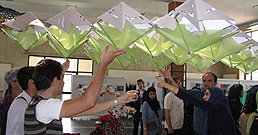The history of modern education in Iran can be traced back to the early nineteenth century with the despatch of a handful of students to England to study technical and scientific subjects. A generation later the next stage was the establishment of a Polytechnic College in Tehran itself, initially concentrating on military subjects with Austrian instructors but quickly expanding to cover a wide range of scientific disciplines, medicine and languages. The tradition of employing foreign teachers continued and expanded through the Pahlavi period, but at a deeper level there was never much interaction with Iranian society. Foreign professors came and went, delivered their specialized learning in formal lectures and differed little from their Iranian colleagues in the rigid and stereotypical methods of instruction.
But recently the Department of Architecture of Tehran University, in conjunction with the Architectural Association in London, pioneered a different approach to the learning experience. The concept of the workshop is commonplace in European institutions of higher education but it has not been used to any great effect in an Iranian context. Through the help of Hamid Nasser Khaki, who spent a year at the Architectural Association in 2006, Omid Kamvari Moghadam in the department of Architecture in Tehran University has been able to bring a whole workshop from the Architectural Association to show how the concept of the workshop has the capacity to transform time-honoured methods of instruction.
Instead of the single European professor invited to give a course of lectures, there were large numbers of foreign professors and their students interacting with their Iranian colleagues and fellow students in a joint enterprise. Instead of a topic that has little relevance to the Iranian experience, the issue chosen for discussion was one that confronted traditional elements in Iranian architecture, such as the wind tower, or the moqarnas (arches or ceilings moulded in a stalactite form), which were subjected to close analysis with the very latest computer techniques. The project was given the intriguing, overall title of ‘Manufacturing Simplexities’.
Yet the significance of this initiative does not just rest with the bringing together of over 60 Iranian and foreign students and their teachers in one large workshop on an architectural theme. It lies in a radical approach to the collaboration between student and teacher towards achieving a common goal, moving beyond the formulaic ‘question and answer’ pattern of traditional instruction to a much more democratic interchange between the generations. In that sense it might have profound pedagogic, social and cultural implications.
In this multimedia report, Omid Kamvari Moghaddam explains how this innovative joint workshop enabled the application of modern computer technology to ancient architectural designs in Iran.


